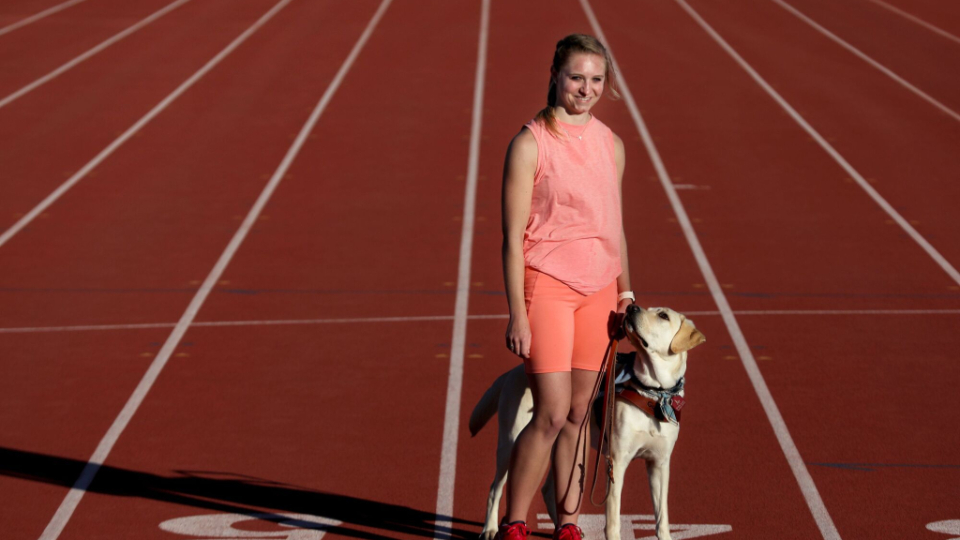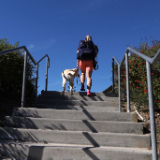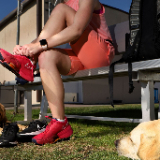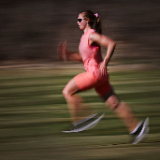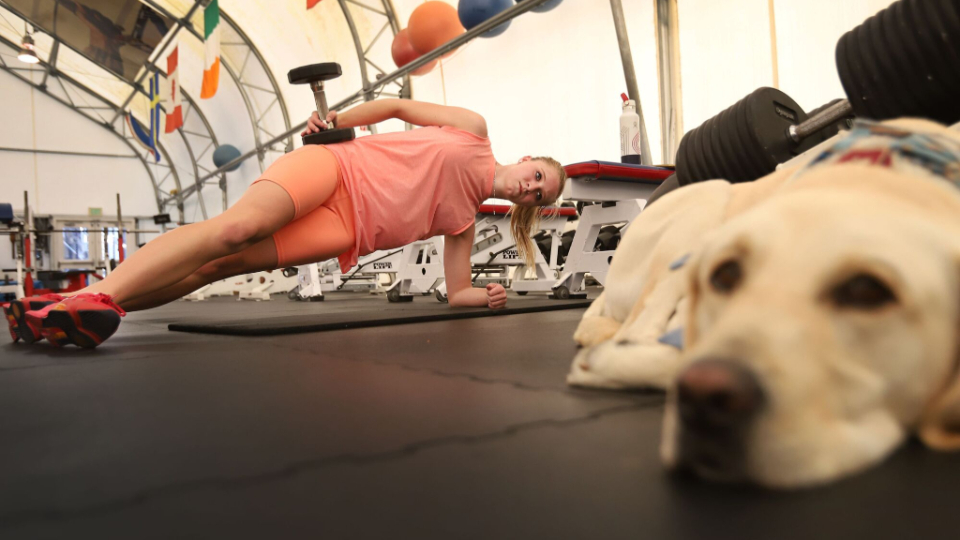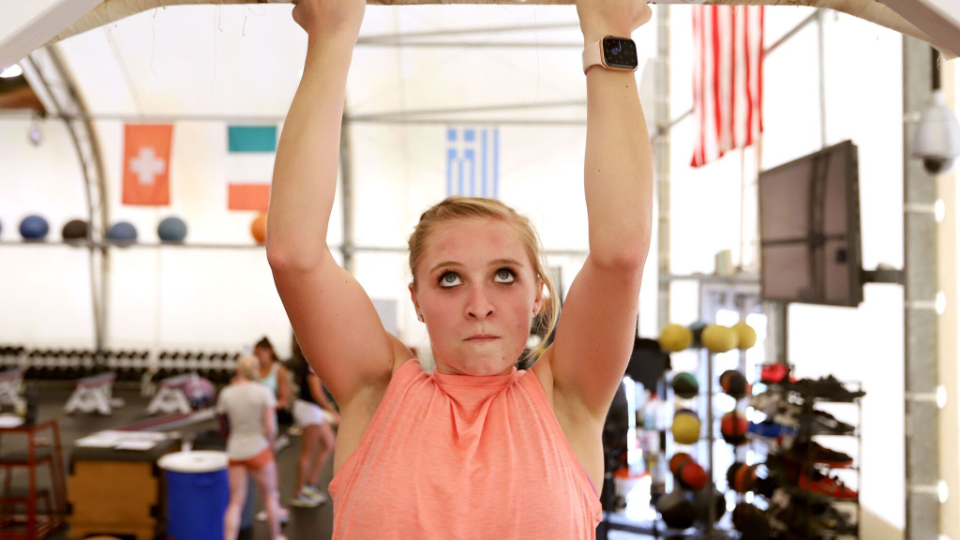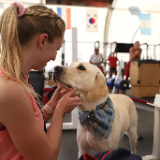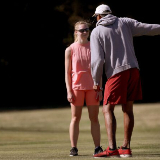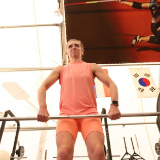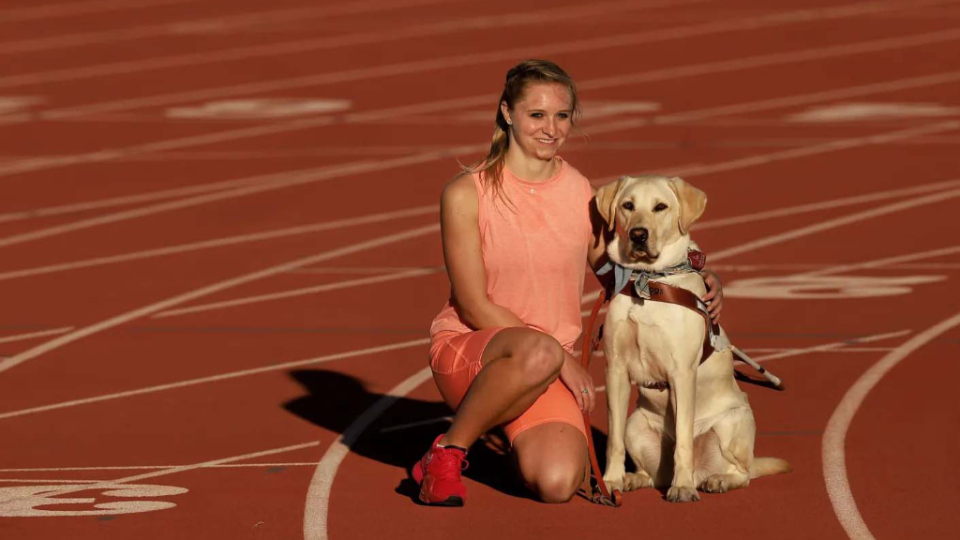
Taylor-Talbot-1
Taylor Talbot, 21, with her new service dog, Fargo, at the Chula Vista Elite Athlete Training Center in Chula Vista, California, on Tuesday, November 15, 2022. Talbot is legally blind and is a Paralympic hopeful in the 100-, 200- and 400-meter and long jump events that will be held in Paris, France, in 2024. Talbot is also on a service mission for The Church of Jesus Christ of Latter-day Saints. Photo by Rick Loomis, courtesy of Church News.All rights reserved.
This story appears here courtesy of TheChurchNews.com. It is not for use by other media.
By Trent Toone, Church News
Led by a guide dog named Fargo and wearing her sprinter’s spikes, Taylor Talbot began her service mission this month for The Church of Jesus Christ of Latter-day Saints.
Talbot, a legally blind Latter-day Saint who competed for the United States in the 2020 Paralympic Games in Tokyo, Japan, will serve for 18 months in unique fashion — training and competing in track and field while speaking at Church-sponsored events, possibly using her musical talents, doing temple work, acts of service and other missionary-related activities in the San Diego, California, area.
“I’m not sure if this has been done before,” the 21-year-old said. “I don’t know if there has been an Olympian or Paralympian who has served at the same time they are doing their sport. ... All I know is I’m going to be doing a lot of public speaking about my life, the miracles I’ve seen, and about Jesus Christ and having faith in Him. ... I’m just going to do what the Lord wants.”
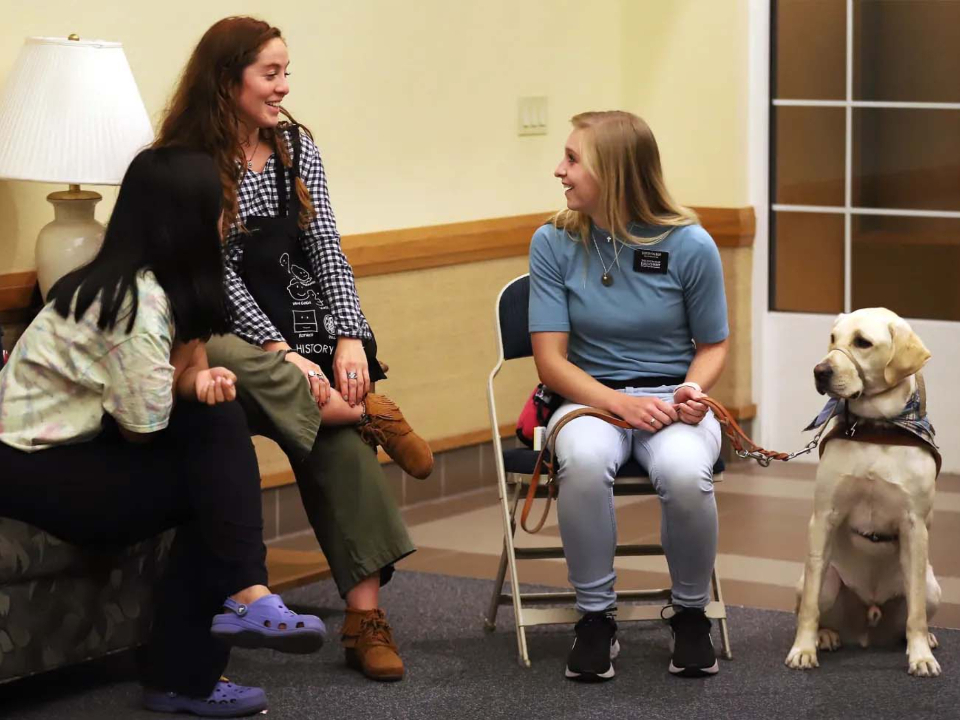
Taylor-Talbot-2
Taylor Talbot, 21, talks with friends during family home evening at The Church of Jesus Christ of Latter-day Saints in Chula Vista, California, on Tuesday, November 15, 2022. Talbot, of Ontario, Oregon, is on a service mission for the Church and spends most of her days training for track and field events as a Paralympic hopeful in the 100-, 200- and 400-meter and long jump events that will be held in Paris, France, in 2024. Photo by Rick Loomis, courtesy of Church News.All rights reserved.
Meet Sister Talbot
Taylor’s parents, Ron and Stacie Talbot, met as scholarship student-athletes on the Southern Utah University track and field team. He was just home from a mission, she was a convert, and they got married.
Taylor was their first child, and it didn’t take the little girl long to develop a passion for the family sport. She began running on the track as a toddler and was participating in athletic competitions in Nyssa, Oregon, by age 4.
Talbot lost most of her eyesight at an early age, around 2 or 3 years old, but was not diagnosed with retinitis pigmentosa, a degenerative eye disease, until she was 8.
Today she is completely blind in her right eye, and the vision in her left eye is comparable to looking through a drinking straw.
Talbot can read in large print but mostly uses audio and voice features on her mobile device to function each day. She is also learning Braille.
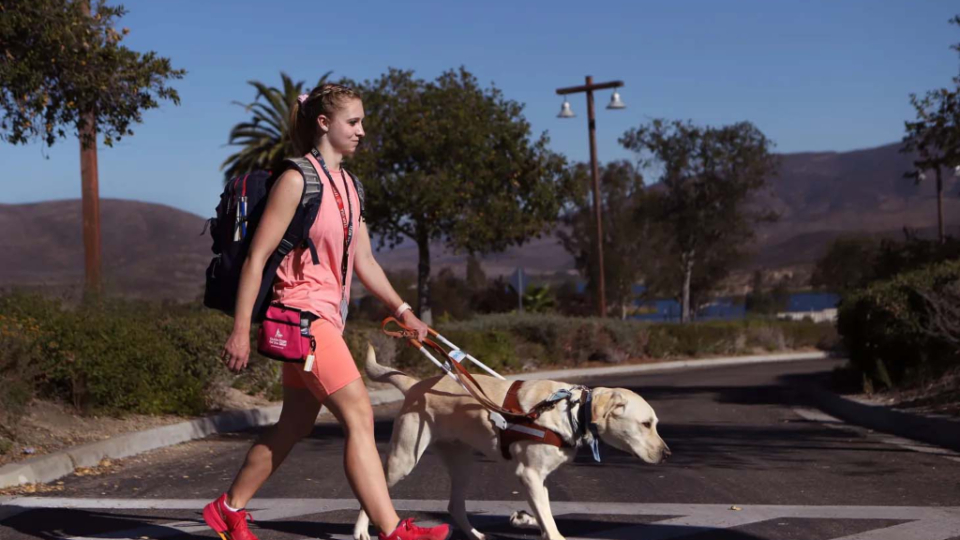
Taylor-Talbot-3
Taylor Talbot, 21, uses Fargo, her service dog, to navigate the campus at the Chula Vista Elite Athlete Training Center in Chula Vista, California, on Tuesday, November 15, 2022. Talbot is legally blind and is a Paralympic hopeful in the 100-, 200- and 400-meter and long jump events that will be held in Paris, France, in 2024. Talbot is also on a service mission for The Church of Jesus Christ of Latter-day Saints. Photo by Rick Loomis, courtesy of Church News.All rights reserved.
‘Solid Plan’
Talbot laughs to herself now when she remembers how she had her life all planned out in early 2020.
“It was a solid plan,” she said.
First, the BYU-Idaho student wanted to qualify for the U.S. Paralympic team and compete in Japan.
While that was happening, she would submit paperwork for a teaching mission so when the Tokyo games were over, she could serve for 18 months and return with more than two years to prepare for the 2024 Paralympic Games in Paris.
What could go wrong?
One major unexpected event was the COVID-19 pandemic, which postponed the 2020 Paralympics Games until 2021. Talbot wasn’t sure if she should serve a mission or pursue the Paralympics.
She prayed and didn’t feel any heavenly impressions either way, so she decided to move forward with the Paralympics. It was difficult because she was forced to train alone. There was no guarantee of making the squad. She also wrestled with knowing she could be serving as a missionary.
“That was the hardest thing I’ve ever done,” she said.
| Taylor Talbot, 21, with her service dog, Fargo, at the Chula Vista Elite Athlete Training Center in Chula Vista, California, on Tuesday, November 15, 2022. Talbot is legally blind and is a Paralympic hopeful in the 100-, 200- and 400-meter and long jump events that will be held in Paris, France, in 2024. Talbot has had Fargo for about a month, and they are still practicing their working relationship with each other. Photo by Rick Loomis, courtesy of Church News. All rights reserved. | 1 / 4 |
When the Paralympic track and field team was announced, Talbot was the final name on the roster. But the next day brought bad news — she was told that there was a calculation error and that she wasn’t on the team.
Talbot thought this meant the Lord wanted her to serve a mission, but she felt a spiritual impression to hold off on submitting paperwork and continue training. Less than two weeks later, she received a call to join the U.S. team as an alternate and compete in Tokyo.
“I knew I had made the right choice,” she said.
Talbot ran the 100-meter T13 (for visual impairments) race in 13.33 seconds, finishing fifth in her heat but not qualifying for the finals. She finished 17th overall in that event.
Talbot also competed in the 400-meter T13 race and finished fourth in her heat, with a time of 1:04.76, but did not advance to the finals.
Chula Vista, California
Talbot’s desire to serve a mission persisted after competing in the Tokyo Paralympics.
She continued to pray for guidance and felt impressed to keep training for track and field.
“Maybe track and field is my mission,” she thought.
She prayed for the blessing of living and training at the U.S. Olympic and Paralympic Training Center in Chula Vista, California. Her prayer was answered with an invitation to join the center, and she moved to the center in California.
The move felt right because it came with ample missionary opportunities.
“Every single day I was teaching somebody the gospel,” Talbot said. “I was teaching athletes, people who worked here. I was teaching somebody on every flight I was on. I taught people in Ubers. I even gave out copies of the Book of Mormon. I never initiated those conversations. I’m like, ‘Oh my goodness, I’m on my mission.’”
Another spiritual prompting instructed her to prepare for missionary service, so she organized her daily schedule as if she was a missionary. She woke early for scripture study before track and field training. She continued having missionary conversations and praying to know the Lord’s will for her.
| Taylor Talbot, 21, trains with her dog nearby at the Chula Vista Elite Athlete Training Center in Chula Vista, California, on Tuesday, November 15, 2022. Talbot is legally blind and is a Paralympic hopeful in the 100-, 200- and 400-meter and long jump events that will be held in Paris, France, in 2024. Talbot is also on a service mission for The Church of Jesus Christ of Latter-day Saints. Photo by Rick Loomis, courtesy of Church News. All rights reserved. | 1 / 9 |
‘Special Mission’
Inspiration came again when President Russell M. Nelson and other Church leaders spoke at a devotional for Latter-day Saint stakes in California in February on the topic of “California, Covenants and the Gathering of Israel.”
“I remember him saying ‘You have been brought to California at this time to preach the gospel,’” she said. “He was talking about me.”
Talbot was moved by the prophet’s message and grateful for more answers to prayers. She wrote a letter to President Nelson thanking him for his remarks. The letter found its way to her stake president, who invited her for a visit.
As they discussed her situation, the stake president asked Talbot if she wanted to serve a mission.
“Honestly, I feel like I’m already on one,” she said.
The stake president encouraged her to keep doing what she was doing.
A few months passed and the stake president called Talbot in again. She was expecting him to extend a calling, but he surprised her with “amazing news.” He had been in contact with leaders at Church headquarters and told me that “God had called me to serve a special mission,” she said.
Tears rolled down her cheeks as he extended a call for her to serve a service mission customized for her unique talents. She accepted on the spot.
‘Losing My Sight’ To Help ‘Others See Christ’
Talbot was surrounded by friends at a ward activity when she opened her official mission call. The tender moment was recorded on video and later posted on social media.
“The stake president ... told me that God had called me to serve a very special mission here in Chula Vista and that I was sent here to help people and teach them about Christ. I wouldn’t be here if it wasn’t for the challenges that I have been blessed with,” she said. “I am so grateful that I get to see the world in a way that nobody else can. I am so grateful for that challenge God gave me that I am losing my sight so that I can help others see Christ and come unto Him.”
| Taylor Talbot, 21, plays piano during a family home evening at The Church of Jesus Christ of Latter-day Saints in Chula Vista, Calfiornia, on Tuesday, November 15, 2022. Talbot is an accomplished piano player and a music minor at Brigham Young University–Idaho. Photo by Rick Loomis, courtesy of Church News. All rights reserved. | 1 / 3 |
Talbot is one of more than 2,200 young service missionaries currently serving across the world. Worthy young men ages 18–25 and young women ages 19–25 may serve a service mission for six to 18 months, as close to full time as their capability and circumstances allow.
Service missionaries can live at home and serve locally. Missions can be tailored to a missionary’s unique talents, skills and abilities, offering opportunities to serve in approved charitable organizations, Church operations and other stake-assigned service opportunities, according to ChurchofJesusChrist.org.
Guide Dogs and Guide Runners
Like most who are visually impaired, Talbot says she will bump into things and occasionally trip and fall. She now relies greatly on her new guide dog, Fargo, to help her get around.
“He’s my eyes,” she said.
On the track, Talbot has no peripheral vision but can still detect the running lanes. As her eyesight continues to get worse, she will enlist some help.
Visually impaired sprinters can race with a guide, who is attached to them with a band at the wrist or hand. The guide’s role is run alongside the visually impaired runner and be their eyes during the race.
Talbot anticipates using a guide runner this season as she trains and competes in the 100-, 200- and 400-meter races, ahead of world-class events in France and Chile in 2023. She will also compete in the long jump event.
“Some races I’ll have a guide runner when my eyes aren’t doing so well,” she said. “Other days, if my eyes are feeling good, I’ll probably run on my own. I’m in the phase where I can choose.”
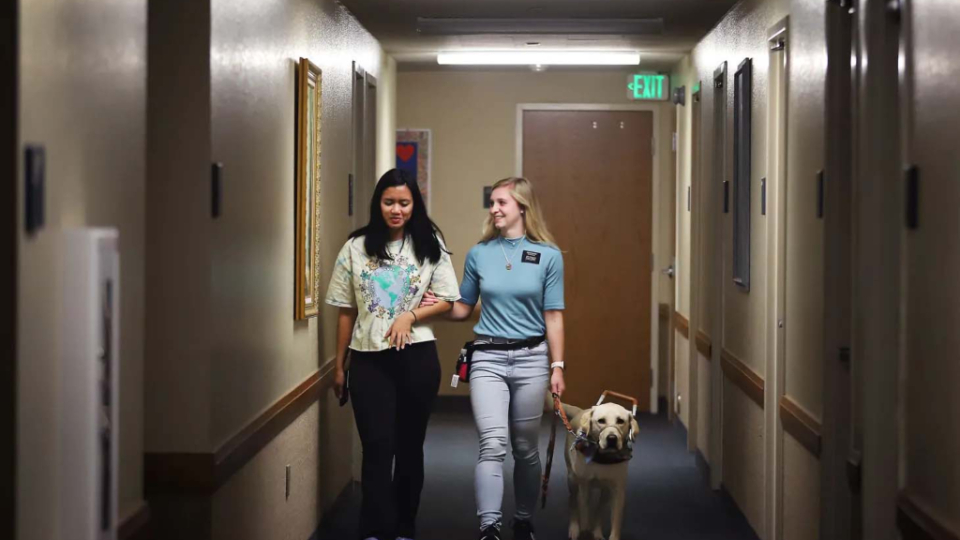
Taylor-Talbot-23
Taylor Talbot, 21, walks sandwiched between one of her best friends, Beatrice Dela Cruz, 22, and her service dog, Fargo, during a family home evening at The Church of Jesus Christ of Latter-day Saints in Chula Vista, California, on Tuesday, November 15, 2022. Photo by Rick Loomis, courtesy of Church NewsAll rights reserved.
Seeing Trials With New Eyes
Talbot says she would not be the person she is today without her visual impairment. She hopes those who read her story will see their trials with new eyes.
“I have been able to reach more people and teach them about the gospel than I ever could have if I was fully sighted,” she said. “It’s opened my eyes to a lot of good things in the world. I have a completely different perspective on trials because of it. I’ve been able to be more grateful and become more aware of the miracles and tender mercies that God has put into my life. It’s just so much easier to see God’s hand when I can’t see physically.”
Copyright 2022 Deseret News Publishing Company.
